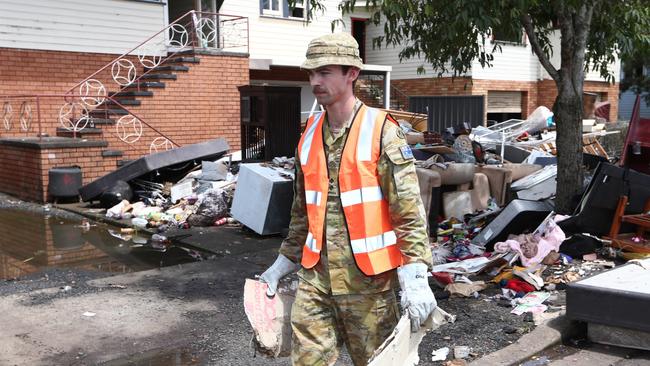ADF ‘being stretched to the limit’
Defence force personnel are increasingly being used during natural disasters and diverted away from their main responsibilities.

Defence force personnel are increasingly being used during natural disasters and diverted away from their main responsibilities, prompting experts to warn the ADF is being stretched to its limit.
More than 2200 ADF personnel have been rolled out across flood-affected areas so far, with Defence Minister Peter Dutton estimating about 5000 will be on the ground by the end of the week.
Australian Defence Association executive director Neil James said the frequency at which ADF forces were being diverted from their primary role was concerning, particularly at a time when tensions were rising in the region.
“We’re in the third year now of extensive ADF assistance to emergencies and natural disasters,” Mr James told The Australian.
“We have had the bushfires, Covid-19, the aged-care crisis and now these floods. The force is overstretched. Anytime they get diverted to civil assistance tasks, it’s a diversion from their primary role, and that’s deterring wars.” He added that the ADF was “almost at crisis point” after being pulled between so many different roles.
Mr James said the criticism from the public and some members of the opposition that the ADF had not been mobilised fast enough in the latest floods crisis was not helpful.
“They can’t do everything, everywhere, all of time and they certainly can’t do it instantly,” he said. “A lot of people are saying ‘why weren’t they there the next day?’… when that’s not physically or geographically possible.
“What has to change is that we need to educate the wider Australian community about what the ADF can and can’t do, and why.”
The ADF is conducting relief and recovery efforts under Operation Flood Assist, and is helping with clean-up operations in about 10 major areas across Queensland and 14 across NSW.
Forces are also providing food and water supplies to residents in isolated communities including Cawonga, Grafton, Lawrence, Lismore, Maclean, Tumbulgum, Wardall and Woodburn.
ADF personnel are also helping Telstra restore communication services across some regions, and there are numerous helicopter crews on standby across Queensland and NSW for search and rescue operations.
Former major general Peter Dunn – who retired from the ADF in 2002 to become the ACT Emergency Services Authority commissioner before helping found the Emergency Leaders for Climate Action – said the ADF was “now being called out every other year” to help with natural disasters.
“We weren’t worried about it when I was serving … it was never a threat to our training standard. I would argue now that it is a serious threat,” he said. “There is a concern this is happening so frequently because of climate supercharged weather events, and it will keep happening.”
Mr Dunn said the government needed to urgently address climate change to prevent natural disasters, rather than be purely reactive and send in the ADF once such major events had happened.
The government is under fire for not mobilising resources like the ADF quickly enough, with Mr Dutton defending the response.
“I’m not going to cop criticism of the ADF,” he said on Tuesday.




To join the conversation, please log in. Don't have an account? Register
Join the conversation, you are commenting as Logout